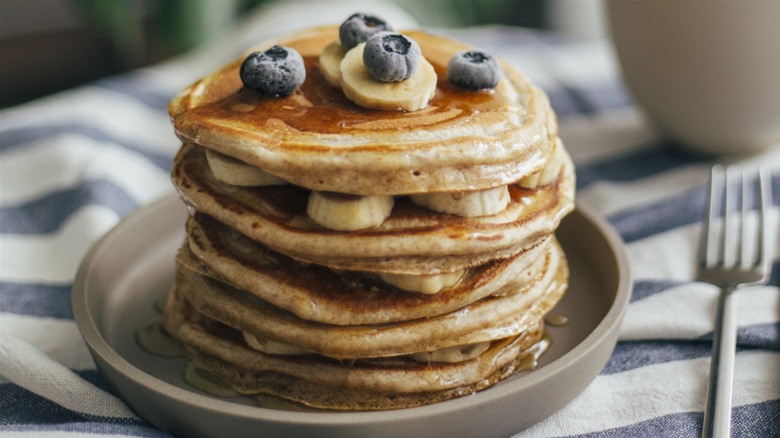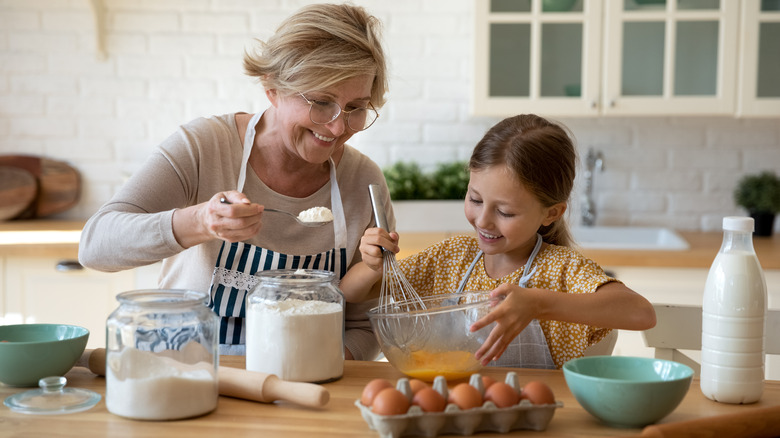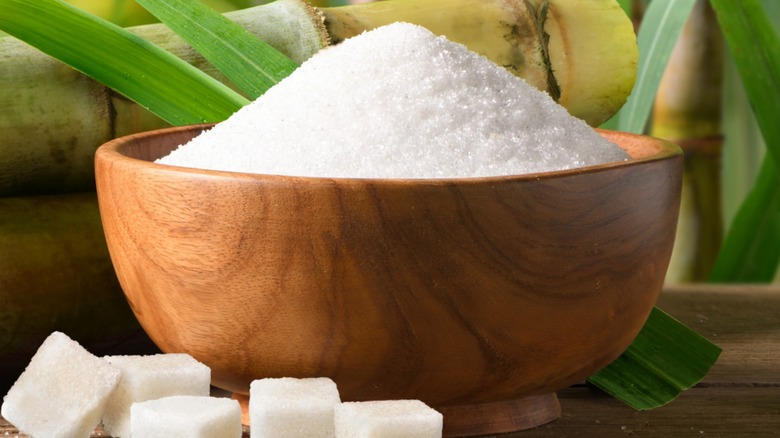Skimping On Sugar In Your Pancake Batter Is A Huge Mistake
Pancakes, a cornerstone of many breakfast setups, might seem to be one of the easier dishes to make. However, these seemingly simple discs of batter can be tricky to get just right. Although most pancake recipes use few ingredients and are highly customizable, those basic ingredients are important to include as directed. One of those crucial ingredients is sugar; and even though very little sugar is called for, don't skip or even skimp on it.
When making sweet flapjacks, such as apple-cinnamon buttermilk pancakes, you might think the sugar is to enhance a decadent flavor profile. Those who prefer savory pancakes over sweet ones or who are health-conscious may think sugar is unnecessary. Already chock full of carbs and additional sweet toppings, pancakes may not seem to require sugar in the batter. However, sugar does more than appeal to one's sweet tooth.
Adding sugar to even a classic pancake recipe is necessary for not just taste but consistency and texture. Even boxed pancake mixes contain some elements of sugar. Without sugar, the pancakes will not have the texture most pancake lovers prefer — a crisp, delicious crust that encases a pillow-soft interior. Without sugar, the chemical reaction that causes this would not occur, and you'll be left with mushy and lifeless flapjacks.
Sugar adds many benefits to pancakes
In any dish, consistency and texture are often as important as taste. These elements can be what separates merely acceptable fare from a delectable achievement. You may douse your pancakes in syrup and butter, but that won't be enough to overcome poor texture inside and out. Sugar is crucial to developing the ideal interior and exterior of pancakes. On the inside, sugar acts as a binding agent in pancake batter. After sugar is combined with the liquid, it reduces moisture, which slows gluten production. Less gluten means the batter is less rubbery and rises more when cooked. This reaction creates pancakes with a fluffier consistency.
The inclusion of sugar in batter not only fluffs up the inside of a pancake, but it also has an opposite yet equally desirable effect on the pancake's exterior as well. Sugar triggers caramelization on the surface of pancakes when the batter is poured into a hot skillet or griddle, which results in the batter turning rich, golden brown, and developing crisp, chewy edges.
However, make sure you don't overdo it with the sugar. Pancake recipes typically call for around 2 tablespoons of sugar. While there is wiggle room with almost any recipe, using too much sugar makes it hard for the batter to form into discs, and risks pancakes browning too quickly or even burning. No sugar at all, and you'll end up with pancakes that are probably flat, dense, and tough.
The best sugars to use in pancake batter
Using the right kind of sugar in pancake batter is as important as not skimping on it. Granulated (table) sugar is a safe bet for many recipes, and you can't go wrong using granulated sugar in your pancake mix. However, you can safely stray from granulated sugar if you are looking for substitutions. Coconut sugar and raw sugar also work in pancakes, because they have similar flavor profiles to granulated sugar.
Powdered sugar, can really fluff up your pancakes because this type of sugar contains cornstarch, which has a softening quality. However, powered sugar doesn't have flavor as pronounced as table sugar, so if want pancakes that are fluffy and sweet, powdered sugar may not be your best bet. Brown sugar comes with even more caveats. Brown sugar is white sugar combined with molasses — the higher the molasse-to-sugar ratio, the darker the brown sugar. The flavor and moisture in molasses affect the flavor of the sugar and will introduce a heavier taste and texture to pancakes.
As customizable to personal taste preferences as pancakes are, the basic ingredients are integral to making great pancakes, including those 2 tablespoons of sugar.


